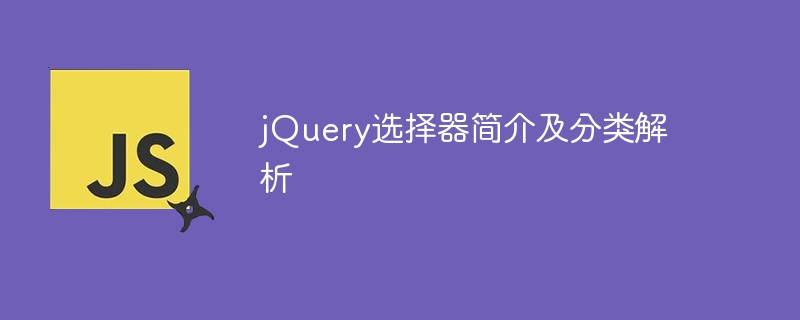Home >Web Front-end >JS Tutorial >Introduction to jQuery selector and classification analysis
Introduction to jQuery selector and classification analysis
- PHPzOriginal
- 2024-02-28 12:06:04685browse

jQuery selector introduction and classification analysis
jQuery is an extremely popular JavaScript library that is widely used in web development. Among them, selectors are a very important part of jQuery, which allow developers to select elements from HTML documents and operate on them through concise syntax. This article will briefly introduce the basic concepts of jQuery selectors, analyze their classification in detail, and provide specific code examples to help readers better understand.
1. Introduction to jQuery selectors
When using jQuery, selectors are used to specify the HTML elements that need to be operated, and their syntax is similar to CSS selectors. Through selectors, you can select a single element, a group of elements, or all elements in the entire page to easily operate on them, modify styles, or bind events.
2. jQuery selector classification analysis
1. Basic selector
Basic selector is used to select a single element or a group of elements in an HTML document. Commonly used basic selectors include:
-
Element selector: Select elements by their tag names, the syntax is
$("element"). For example, to select all<p></p>elements:$("p"). -
ID selector: Select elements through their id attribute, the syntax is
$("#id"). For example, select the element with the id"demo":$("#demo"). -
Class selector: Select elements through their class attributes, the syntax is
$(".class"). For example, select the element with class"info":$(".info"). -
Attribute selector: Select elements by their attributes, the syntax is
$("[attribute='value']"). For example, select the element whose attributedata-idhas the value"123":$("[data-id='123']").
2. Hierarchical selector
The hierarchical selector is used to select the hierarchical relationship of elements. Commonly used hierarchical selectors include:
-
Descendants Selector : Selects the descendant elements of the specified element, the syntax is
$("parent descendant"). For example, to select all<p></p>elements inside<div>: <code>$("div p"). -
Child element selector: Select the child elements of the specified element, the syntax is
$("parent > child"). For example, to select all<span></span>elements directly under<div>: <code>$("div > span"). -
Adjacent sibling selector: Select the adjacent sibling elements of the specified element, the syntax is
$("prev next"). For example, select a<span></span>element immediately after the<p></p>element:$("p span"). - ## :first: Selects the first element matching the selector.
- :last: Selects the last element matching the selector.
- :even: Selects elements matching the even positions of the selector.
- :odd: Selects elements matching the odd position of the selector.
- :eq(index): Selects elements matching the index position specified in the selector.
3. Filter selector
Filter selector is used to select elements that meet specified conditions. Commonly used filter selectors include:
<!DOCTYPE html>
<html>
<head>
<title>jQuery选择器示例</title>
<script src="https://code.jquery.com/jquery-3.6.0.min.js"></script>
</head>
<body>
<div>
<p>Hello, jQuery!</p>
</div>
<div id="example">
<p class="info">This is a paragraph.</p>
<p>This is another paragraph.</p>
</div>
<script>
// 基础选择器示例
$("p").css("color", "blue"); // 改变所有<p>元素的颜色为蓝色
$("#example .info").html("Updated content"); // 修改id为example内class为info的元素的内容
// 层级选择器示例
$("div > p").css("font-weight", "bold"); // 选取div下的直接子元素p并设置字体加粗
// 过滤选择器示例
$("p:first").css("background-color", "yellow"); // 选取第一个<p>元素并设置背景色为黄色
</script>
</body>
</html>Through the above code examples, readers can Have an intuitive understanding of the different types of jQuery selectors, and use them flexibly to operate HTML elements in actual development. <p></p>ConclusionThe jQuery selector, as an important part of the jQuery library, brings convenience and efficiency to web development. Through the introduction and examples of this article, I hope readers can have a deeper understanding and mastery of various types of jQuery selectors, so as to develop excellent web applications more efficiently. <p></p>
The above is the detailed content of Introduction to jQuery selector and classification analysis. For more information, please follow other related articles on the PHP Chinese website!

